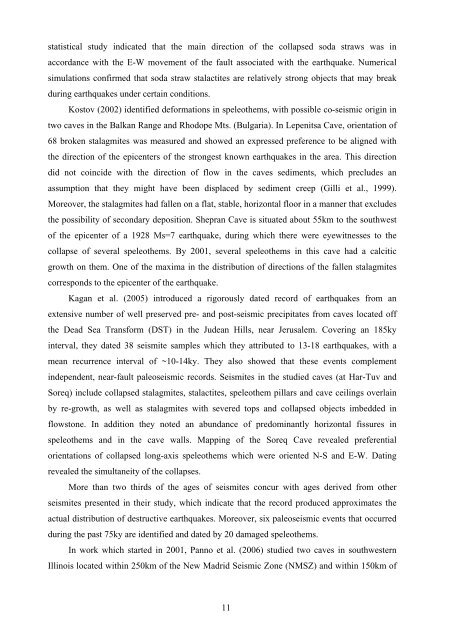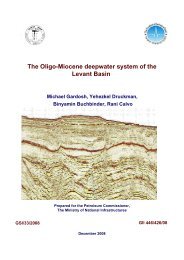tivity on the carmel faul
tivity on the carmel faul
tivity on the carmel faul
Create successful ePaper yourself
Turn your PDF publications into a flip-book with our unique Google optimized e-Paper software.
statistical study indicated that <strong>the</strong> main directi<strong>on</strong> of <strong>the</strong> collapsed soda straws was in<br />
accordance with <strong>the</strong> E-W movement of <strong>the</strong> <strong>faul</strong>t associated with <strong>the</strong> earthquake. Numerical<br />
simulati<strong>on</strong>s c<strong>on</strong>firmed that soda straw stalactites are relatively str<strong>on</strong>g objects that may break<br />
during earthquakes under certain c<strong>on</strong>diti<strong>on</strong>s.<br />
Kostov (2002) identified deformati<strong>on</strong>s in speleo<strong>the</strong>ms, with possible co-seismic origin in<br />
two caves in <strong>the</strong> Balkan Range and Rhodope Mts. (Bulgaria). In Lepenitsa Cave, orientati<strong>on</strong> of<br />
68 broken stalagmites was measured and showed an expressed preference to be aligned with<br />
<strong>the</strong> directi<strong>on</strong> of <strong>the</strong> epicenters of <strong>the</strong> str<strong>on</strong>gest known earthquakes in <strong>the</strong> area. This directi<strong>on</strong><br />
did not coincide with <strong>the</strong> directi<strong>on</strong> of flow in <strong>the</strong> caves sediments, which precludes an<br />
assumpti<strong>on</strong> that <strong>the</strong>y might have been displaced by sediment creep (Gilli et al., 1999).<br />
Moreover, <strong>the</strong> stalagmites had fallen <strong>on</strong> a flat, stable, horiz<strong>on</strong>tal floor in a manner that excludes<br />
<strong>the</strong> possibility of sec<strong>on</strong>dary depositi<strong>on</strong>. Shepran Cave is situated about 55km to <strong>the</strong> southwest<br />
of <strong>the</strong> epicenter of a 1928 Ms=7 earthquake, during which <strong>the</strong>re were eyewitnesses to <strong>the</strong><br />
collapse of several speleo<strong>the</strong>ms. By 2001, several speleo<strong>the</strong>ms in this cave had a calcitic<br />
growth <strong>on</strong> <strong>the</strong>m. One of <strong>the</strong> maxima in <strong>the</strong> distributi<strong>on</strong> of directi<strong>on</strong>s of <strong>the</strong> fallen stalagmites<br />
corresp<strong>on</strong>ds to <strong>the</strong> epicenter of <strong>the</strong> earthquake.<br />
Kagan et al. (2005) introduced a rigorously dated record of earthquakes from an<br />
extensive number of well preserved pre- and post-seismic precipitates from caves located off<br />
<strong>the</strong> Dead Sea Transform (DST) in <strong>the</strong> Judean Hills, near Jerusalem. Covering an 185ky<br />
interval, <strong>the</strong>y dated 38 seismite samples which <strong>the</strong>y attributed to 13-18 earthquakes, with a<br />
mean recurrence interval of ~10-14ky. They also showed that <strong>the</strong>se events complement<br />
independent, near-<strong>faul</strong>t paleoseismic records. Seismites in <strong>the</strong> studied caves (at Har-Tuv and<br />
Soreq) include collapsed stalagmites, stalactites, speleo<strong>the</strong>m pillars and cave ceilings overlain<br />
by re-growth, as well as stalagmites with severed tops and collapsed objects imbedded in<br />
flowst<strong>on</strong>e. In additi<strong>on</strong> <strong>the</strong>y noted an abundance of predominantly horiz<strong>on</strong>tal fissures in<br />
speleo<strong>the</strong>ms and in <strong>the</strong> cave walls. Mapping of <strong>the</strong> Soreq Cave revealed preferential<br />
orientati<strong>on</strong>s of collapsed l<strong>on</strong>g-axis speleo<strong>the</strong>ms which were oriented N-S and E-W. Dating<br />
revealed <strong>the</strong> simultaneity of <strong>the</strong> collapses.<br />
More than two thirds of <strong>the</strong> ages of seismites c<strong>on</strong>cur with ages derived from o<strong>the</strong>r<br />
seismites presented in <strong>the</strong>ir study, which indicate that <strong>the</strong> record produced approximates <strong>the</strong><br />
actual distributi<strong>on</strong> of destructive earthquakes. Moreover, six paleoseismic events that occurred<br />
during <strong>the</strong> past 75ky are identified and dated by 20 damaged speleo<strong>the</strong>ms.<br />
In work which started in 2001, Panno et al. (2006) studied two caves in southwestern<br />
Illinois located within 250km of <strong>the</strong> New Madrid Seismic Z<strong>on</strong>e (NMSZ) and within 150km of<br />
11

















